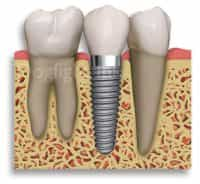Some researchers will have the opportunity to publish a study on dental coatings in the next issue of the International Journal of Nanomanufacturing. Titanium is the most used material in many dental implants, however its surface is typically inert: this makes it biocompatible and favored to avoid adverse reactions of the immune system, but it is not bioactive and therefore does not help the integration of bone tissue nor of the proliferation of blood vessels. The dichotomy explained here has been addressed and has led to the description of a synthetic bone tissue, formed by hydroxyapatite reinforced with tiny glass fragments. Professor JD Santos of the Biomedical Engineering Institute in Porto evaluated the presence of this coating on seven patients with a total of 27 implants 10mm long and almost 4mm wide; the connection of the first 18 was made to the maxilla, while the last 9 to the mandibular level. An X-ray evaluation made by the team at both three and six months demonstrated an effective increase in the bioactivity of the implant, however in only one case was forced removal required. The researchers say they are completely satisfied because in any case it was due to a bad positioning, not to an interaction of the material. [via nanowerk | dogfightink pics ]
You may also like
Plaque detector
Scientists at the University of Liverpool have developed a new dental product to identify plaque before it is visible to the human eye alone. The device is the size of a toothbrush and emits light that must be viewed with special yellow glasses with a red filter. In doing so, the plaque – if present… Continua a leggere Plaque detector
Dental Implants: Methods, Treatments and focusing on younger patients
Dental implants have revolutionized dental care, offering a potent solution for tooth loss. This article delves into the methods and treatments available, focusing on younger patients, under 55, while exploring new research studies that could redefine dental implantology.
Dental Aligners: Treatment Options for Adults
Dental aligners have revolutionized orthodontics, offering adults a discreet solution to teeth misalignment. This article explores various methods and treatments available, challenges faced by adults, and emerging studies in experimental aligners. Additionally, it delves into regional trends and geographic incidence of treatments.
Dental Implants: Modern Techniques and Emerging Research
Dental implants have revolutionized the field of dentistry, providing patients with robust solutions for replacing missing teeth. This article delves into various methods and treatments available for dental implants, particularly focusing on challenges faced by individuals under the age of 55. Additionally, it explores cutting-edge research and new developments in implant technology, including experimental studies. The piece also examines the geographical distribution and incidence of dental implant procedures globally.
Dental Implants: Transforming Smiles Across Generations
Dental implants have revolutionized the way we approach oral health restoration, offering renewed hope to those suffering from tooth loss. This comprehensive article delves into the methodologies and treatments available, particularly focusing on challenges faced by individuals over 55 years. It also explores cutting-edge research and the geographical incidence of implant procedures globally.
